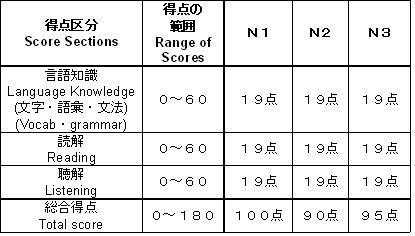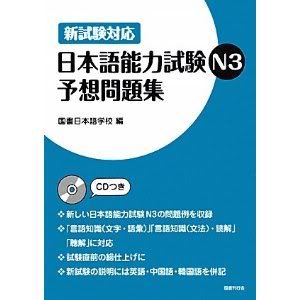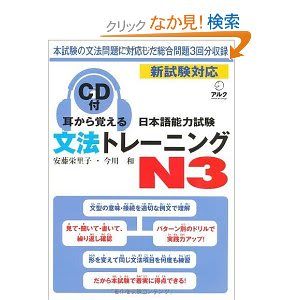Showing posts with label JLPT. Show all posts
Showing posts with label JLPT. Show all posts
December 4, 2010
がんばってくださいね!
みなさん、こんにちは!
忙しくてBlogが書けなくてごめんなさい。
明日JLPTを受けるみなさん、がんばってくださいね!
Sorry for not writing for a while I have been busy.
Gambatte for all who take JLPT tomorrow!
October 22, 2010
JLPT過去のデータ JLPT Past Data
みなさん、こんにちは!
JLPT過去4年のデータです。 JLPT Past 4 years data.
今度12月のテストはどうでしょうか。 がんばってくださいね!
応募者数 受験者数 認定者数 認定率(%)
N1(1kyu) Applicants Examinees Certified Certified (%)
----------------------------------------------------------------------------------------
2010 July 26,225 23,694 9,651 40.7%
2009 Dec 46,648 41,998 12,293 29.3%
2009 July 29,274 26,578 11,738 44.2%
2008 Dec 52,992 46,953 18,454 39.3%
2007 Dec 47,791 42,923 14,338 33.4%
----------------------------------------------------------------------------------------
N2(2kyu)
2010 July 24,738 23,126 13,768 59.5%
2009 Dec 36,528 33,807 12,462 36.9%
2009 July 26,437 24,793 9,279 42.8%
2008 Dec 41,924 38,040 16,289 42.8%
2007 Dec 34,782 31,805 11,884 37.4%
----------------------------------------------------------------------------------------
N3
2010 July 6,947 6,280 3,051 48.6%
----------------------------------------------------------------------------------------
N4(3kyu)
2009 Dec 17,703 16,675 9,360 56.1%
2008 Dec 22,016 20,351 13,304 65.4%
2007 Dec 16,808 15,710 8,664 55.1%
----------------------------------------------------------------------------------------
N5(4kyu)
2009 Dec 3,212 2,932 2,155 73.5%
2008 Dec 4,524 3,903 2,765 70.8%
2007 Dec 3,908 3,383 2,332 68.9%
October 17, 2010
もうすぐJLPT JLPT is coming soon
みなさん、こんにちは!
I have had some students who took JLPT 1kyu or 2kyu every year.
But I do not feel like JLPT is coming soon this year because I have only one student takes N3 this year, but it is in one month a little.
Gambatte kudasai for all of you take it!
I guess maybe you should start to practice past papers or practice exams in order to familiarize yourself with the exam.
If you do not know what the test looks like, you might write your correct answer in wrong way/place and lose your points.
It is a pity if you have an ability to pass it.
And make plans how long you should take on which questions considering your likes and dislikes or strong and weak abilities.
毎年JLPTの1級・2級レベルの生徒さんを担当していましたが、今年はN3の生徒さん一人だけなので、私自身あまり「もうすぐJLPT」という感じがしないのですが、あと1カ月ちょっとですね。
毎年(まいとし): every year
生徒(せいと)さん: students
担当(たんとう)している: my students (in this context),
person in charge
今年(ことし): this year
私(わたし)自身(じしん): myself
あまり感(かん)じがしない: do not feel like
あと1カ月(いっかげつ)ちょっと: a little bit more over one month
受験するみなさん、がんばってください!
そろそろテストに慣れるように、過去問題や予想問題などを始めましょう。
受験(じゅけん)するみなさん: everybody who will take the exam
そろそろ: it’s about time
~に慣(な)れる: familiar, get use to it
~ように: in order to
過去(かこ)問題(もんだい): past exams
予想(よそう)問題: practice exams, mockup exams
始(はじ)める: to start
実力があっても、どんなテストなのかがわからないと、わかっているのに書き方を間違えたらもったいないですからね。
実力(じつりょく)がある: have abilities
~ても: even if
どんなテストなのか: what is the exam like
~がわからないと: if you do not know ~
わかっているのに: even if you know it
書(か)き方(かた): how to write
間違(まちが)えたら: if you would make a mistake
もったいない: what a pitty,
また自分の得意・不得意も考えて、どの問題にどのくらい時間をかけるか、計画をたてましょう。
また: or, and
自分(じぶん)の: you
得意(とくい)・不得意(ふとくい): likes and dislikes
考(かんが)える: to think
時間(じかん)をかける: takes time
計画(けいかく)をたてる: make a plan
September 2, 2010
JLPT N1 - N3 minimum passing/acceptable scores announced / N1~N3の合格基準点発表
みなさん、こんにちは!
JLPTのN1~N3の合格基準点が発表されました。
JLPT from N1 to N3 minimum acceptable scores has been announced.(Seems like English site has not been ready yet.)
7月の結果は9月3日に発送するそうです。
July result will be sent off on Sep. 3rd.

全科目を受験した人を対象に、総合得点と、各得点区分の基準点の二つで合否を判定し、受験者全員に合否結果通知書をもって通知します。
なお、得点区分の得点が一つでも基準点に達していない場合は、総合得点がどんなに高くても不合格になります。
Web Site
Subjecting those who completed all test sections, pass or fail will be determined by the scores for both total as well as each scoring section and all examinees will receive their score reports of the Test.
The requirements for passing have changed so that examinees must now exceed the minimum acceptable score for all test sections.
Failure to exceed the minimum acceptable score (to be announced) in any scoring sections will result in a fail for the entire test, even if your total score is above the minimum acceptable score.
Web Site
August 28, 2010
JLPT Dec 2010 application has been started on Aug 27th JLPT12月の申し込みが8月27日から始まりました。
みなさん、こんにちは!

Application period of JLPT (Japanese Language Proficiency Test) for this December 5th (Sun) has been started from yesterday, August 27th (Fri).
Its due date is October 1st (Fri), exact in 5 weeks.
Don’t forget to apply it!
The number of inquires of JLPT preparation courses are increasing.
Three more months!
Gambarimasho!
今年12月5日(日)のJLPT試験の申し込みが昨日8月27日(金)から始まりました。
締め切りは5週間後の10月1日(金)です。
忘れないようにしましょう!
私の学校にも試験対策コースについての問い合わせが増えてきました。
あと3カ月ですね!
がんばりましょう!
- words & phrases -
今年(ことし): this year
12月(がつ)5日(いつか): December 5th
試験(しけん): exam
申(もう)し込(こ)み: apply, application
昨日(きのう): yesterday
始(はじ)まりました: started
締(し)め切(き)り: due date
5週間(しゅうかん)後(ご): in 5 weeks, 5 weeks later
忘(わす)れないように: don’t forget
私(わたし)の学校(がっこう): my school (the Japanese school that I am working for in Tokyo)
試験対策(たいさく)コース: exam preparation course
問(と)い合(あ)わせ: inquiry
増(ふ)えてきました: increasing
あと3カ月(さんかげつ): three more months
June 29, 2010
JLPT 2010 模擬試験(mock exam) ぎおんご・ぎたいご: onomatopoeic
みなさん、こんにちは。
A student who took a mock exam told me that Giongo・Gitaigo (onomatopoeic) in the test.
I know you do not have much time but please see the online dictionary hope it could help you.
Common japanese onomatopoeia word sounds found in manga
Macaronomatopoeia
N2模擬試験を受けた生徒さんからの情報です。
擬音語・擬態語がでたそうです。
あまり時間がないと思いますが、オンラインの辞書を見つけましたので参考にしてください。
- words & phrases -
模擬(もぎ)試験(しけん): mock exam
情報(じょうほう): information
擬音語(ぎおんご)・擬態語(ぎたいご): onomatopoeic
辞書(じしょ): dictionary
参考(さんこう)にする: consult
May 17, 2010
How many Kanji you think you need to study per day?
みなさん、こんにちは!
I will write about the number of Kanji you study.
This is an ideal/model plan.
Study 2 new Kanji per day, 10 Kanji on weekdays from Monday to Friday and review them on weekend.
52 weeks per year so you can study about 500 Kanji per year.
(I think there are some days that you cannot study.)
You can study up to the N1 Level Kanji (about 2000Kanji) within 4 years by calculation.
But I know it is quite hard.
So think about your plan, maybe study 1 new Kanji everyday or study 3 days from Monday to Wednesday.
2 new Kanji means to study 10 new Kanji phrases too.
(There are about 5 Kanji phrases for each Kanji.)
And you also need to review what you have studied.
For example, 2 new Kanji and review 2 Kanji every day.
You also need to study grammars so 2 Kanji per day looks easy but quite difficult if you are a business person.
Little by little.
Gambatte kudasai!
今日は勉強する漢字の数について書きます。
これはモデルプランです。
新しい漢字を毎日2個、月~金で10個、週末は復習します。
1年は52週間ですから、1年で約500個勉強できます。
(1年で勉強できない日があるでしょう)
計算では4年間でN1レベルまで(約2000個)全部勉強できます。
でもなかなか難しいと思います。
忙しい人は毎日1つにするか、月~水の3日勉強するか、など調整してください。
毎日2個漢字を勉強するということは、毎日10個語彙(ごい)も勉強するということです。
(1つの漢字で約5個の漢字の熟語があります)
そして毎日新しい漢字を勉強しながら復習も必要です。
例えば毎日新しい漢字を2個+と復習の漢字を2個。
仕事をしている人は文法の勉強もしなければなりませんからかなり大変です。
少しずつ、ですね。
がんばってください!
- words & phrases -
今日(きょう): today
勉強(べんきょう)する漢字(かんじ)の数(かず): the number of Kanji one study
~について書(か)きます: I will write about ~
モデルプラン: ideal plan, model plan
新(あたら)しい漢字: new Kanji
毎日(まいにち)2個(こ): 2 Kanji every day
月(げつ)~金(きん): from Monday to Friday
週末(しゅうまつ): weekend
復習(ふくしゅう)します: to review
1年(ねん)は52週(しゅう): there are 52 weeks in a year
1年で約(やく)500個: about 500 Kanji per year
計算(けいさん)では: by calculation
なかなか難(むず)しい: quite difficult
忙(いそが)しい人(ひと): busy people
毎日1つにする: decided to study only one Kanji
~か~か: ~ or ~
調整(ちょうせい)してください: please adjust
(A)ということは(B)ということです: (A) means (B)
語彙(ごい): vocabulary
漢字の熟語(じゅくご): phrases which are compounds by Kanji
そして: and then
(A) ながら (B): do (B) while do (B)
必要(ひつよう)です: need
例(たと)えば: for example
仕事(しごと)をしている人: one who works
~もしなければなりません: have to do ~ too
かなり: fairly
大変(たいへん)です: difficult
少(すこし)しずつ: little by little
May 15, 2010
効果的な漢字の勉強方法 Effective way to memorize Kanji
みなさん、こんにちは!
Seems like there are many Kanji practice applications for iPhon these days.
It must be a good way to review on the train.
You do not have to write Kanji for JLPT because everything is multiple-choice.
There are Kanji look very similar so some of them are easy to get confused though.
One of the most effective ways to memorize is “write and say the kanji at the same time”.
For example, 「方法(ほうほう,method)」 then you say “ほうほう” and write「方法」 on the paper 5-10 times.
I know it is so hard and your hands and shoulders must be get really tired, but I think it is the best way.
最近 iPhon向けの漢字練習アプリがたくさんあるようですね。
電車の中などで復習するときに使えて便利だと思います。
JLPTでは全て選択問題ですから、間違えやすい漢字やよく似ている漢字などが答えにありますが、漢字を書くことはありません。
でも一番頭に残る方法は、言いながら紙に書くことです。
例えば「方法」の場合、「ほうほう」と口で言いながら紙に「方法」と5~10回書きます。
手や肩が痛くなるし、大変ですが一番効果があります。
- words & phrases -
最近(さいきん): in these days
~向(む)け: for
漢字(かんじ)練習(れんしゅう): practicing Kanji
アプリ: application
電車(でんしゃ)の中(なか)で: on the train
復習(ふくしゅう)する: to review
使(つか)える: can be used
便利(べんり): convenient
~と思(おも)います: I think that ~
全(すべ)て: all, everything
選択(せんたく)問題(もんだい): multiple-choice
間違(まちが)えやすい: often make mistakes
似(に)ている: looks similar
答(こた)え: answer
書(か)く: to write
一番(いちばん): the most, the best
頭(あたま)に残(のこ)る: stick in one’s head
方法(ほうほう): method
言(い)いながら紙(かみ)に書く: write with pronouncing
例(たと)えば: for example
場合(ばあい): case
5~10回(かい): 5-10 times
手(て)や肩(かた): hands and shoulders
痛(いた)くなる: gets sore
~し: (to connect reasons)
大変(たいへん): hard work
効果(こうか): have effect
May 11, 2010
「日本人の日本語レベル」 native Japanese people’s Japanese levels
みなさん、こんにちは!
I will write about “native Japanese people’s Japanese levels”.
For example, we do not use so much difficult words when we talk with friends or families.
Probably about JLPT N4 (old 3kyu) we use.
It depends on the topics but talking with N5(old 4kyu) level would be not much problem.
In business situation, we use N2(old 2kyu) level grammars and vocabularies.
It is often said JLPT N4 is “daily conversational level” and N2 is business level.
So N2 is usually required for job hunting in Japan.
今日は「日本人の日本語レベル」について書きたいと思います。
例えば友達や家族と話す時は、普通そんなに難しいことばを使って話しません。
多分JLPTのレベルでN4(旧3級)ぐらいです。
話題にもよりますが、N5ぐらいでもあまり問題がありません。
ビジネスではN2(旧2級)の文法と語彙をよく使います。
JLPTのN4はよく日常会話レベル、N2ビジネスレベルと言われています。
ですからN2が必要条件の会社が多いようです。
- words & phrases -
今日(きょう): today
書(か)きたいと思(おも)います: I think I want to write (lit. meaning)
例(たと)えば: for example
友達(ともだち)や家族(かぞく): friends and families (implying “and others”)
話(はな)す時(とき): we one talk
普通(ふつう): usually, normally
そんなに: not really
難(むずか)しいことば: difficult words
~を使(つか)って話(はな)しません: not to speak using ~
多分(たぶん): probably
旧(きゅう): old
話題(わだい): conversation topics
~にもよります: it depends on ~
あまり~ない(negative form): not really
問題(もんだい)がありません: there are no problems
文法(ぶんぽう): grammars
語彙(ごい): vocabularies
日常(にちじょう)会話(かいわ): daily conversation
~と言われています: (passive) it is said that ~
ですから: therefore
必要(ひつよう)条件(じょうけん): essential qualification, necessary condition
~が多(おお)いようです: seems like there are lots of ~
May 7, 2010
JLPT 2010 July 4th (Sun) application has closed
みなさん、こんにちは!
JLPT for July 4th in Japan application deadline was April 30th.
But, at the moment, the organization has not announced the acceptance line yet.
There are only 2 months left, I wonder when they dicided…
Gambatte kudasai ne!
7月4日(日)に日本で行われるJLPTの申し込みの締め切りは4月30日でした。
でも今現在まだ合格ラインが発表されていません。
あと2カ月しかないのに、いつ決めるつもりなのかな。。。
みなさん、がんばってくださいね!
- words & phrases -
日本で行(おこな)われる: be held
申(もう)し込(こ)み: application
締(し)め切(き)り: deadline
今現在(いまげんざい): at the moment
合格(ごうかく)ライン: acceptance line, pass mark
発表(はっぴょう)されて: (passive) be announced,
あと~しかない(negative form): only
つもり: intention
かな: I wonder
April 27, 2010
JLPT N3 textbooks
みなさん、こんにちは!
JLPT N3のテキストもいろいろ発売されていますね。
Some JLPT N3 Level textbooks are sold now.
レベルがわかると思うので時間のあるときに本屋さんで見てみてください。
Check them at a bookstore when you have time, you can refer its level I think.

ISBN:978-4336051615

ISBN:978-4872177312

ISBN:978-4872177329

ISBN:978-4757418547

ISBN:978-4757418578
April 23, 2010
JLPT N3 Level
みなさん、こんにちは!
今日もJLPT N3について書きましょう。
I will write about JLPT N3 today too.
私の考えるN3のレベルは / N3 Level l think is :
① 漢字 / Kanji 700~800
② 語彙 / Vocabulary 3500~4000
③ 文法 / Grammars
* 旧3級の難しい文法 / difficult old 3kyu grammars
(cf : my Blog page here )
* 旧2級の易しい文法 / easier old 2kyu grammars
④ 読解 / Reading comprehension
* 旧2級の短文と中文 / old 2kyu short & middle length ones
昔のJLPTは60%で合格できました(1級は70%)。
Passing score for old JLPT was 60% (70% for 1kyu).
ちょっと厳しい意見ですが、60%ということはほとんど半分(50%)ということです。
つまり、半分理解していれば合格ができた、ということです。
It may sound a little harsh, but 60% is about half (50%), i.e. one might be able to pass it if he/she understands only half.
ですから、新しいN3のために旧3級の難しい文法をもう一度復習したほうがいいと思います。
So I thought “old 3kyu difficult grammar parts” would probably need to be reviewed for new N3 level.
旧3級/新N4 はとても大切な基本ですからね!
Old 3kyu/new N4 level is very important and basics anyway.
がんばりましょう!
April 18, 2010
2010 New JLPT "minimum acceptable score" has not been announced yet
みなさん、こんにちは!
1月17日に新しいJLPTのことについて書きました。
JLPT Web Site に、
「得点区分の得点が一つでも基準点(現在調整中)に達していない場合は、総合得点がどんなに高くても不合格になります。」
とありますが、3カ月たちますがまだ基準点が決まっていません。
早く知りたいですね!
2010年 第1回 日本語能力試験 実施案内(国内)
(詳細)
6(1)
全科目を受験した人を対象に、総合得点と、各得点区分の基準点の二つで合否を判定し、受験者全員に合否結果通知書をもって通知します。
なお、得点区分の得点が一つでも基準点(現在調整中)に達していない場合は、総合得点がどんなに高くても不合格になります。
試験科目と得点区分は以下のように対応しています。N1、N2、N3の得点区分は「言語知識(文字・語彙・文法)」「読解」「聴解」の3区分です。
-----------------------------------------------------------------------------------------------------------
I wrote about the New JLPT on January 17th.
In JLPT WebSite says that
"Failure to exceed the minimum acceptable score (to be announced) in any scoring sections will result in a fail for the entire test, even if your total score is above the minimum acceptable score."
It's been 3 months now but still not announced yet.
We want to know it sooner!
6(1)
Guidelines for the Japanese Language Proficiency Test in 2010 (July)
(in Japan)
"Subjecting those who completed all test sections, pass or fail will be determined by the scores for both total as well as each scoring section and all examinees will receive their score reports of the Test. "
The requirements for passing have changed so that examinees must now exceed the minimum acceptable score for all test sections.
Failure to exceed the minimum acceptable score (to be announced) in any scoring sections will result in a fail for the entire test, even if your total score is above the minimum acceptable score.
Test sections and scoring sections correspond to each other as per below.
The scoring sections for N1, N2, and N3 are divided into three: Language Knowledge (Vocabulary/Grammar), Reading and Listening respectively.
April 16, 2010
JLPT N3
みなさん、こんにちは!
There was a big difference between JLPT Old Level 2 and Level 3, so N3 is a new level between them from this year.
What do you need to study/prepare for N3?
Lots of Japanese language schools are in trouble too because we have very little information, only knowing N3 is between N2 and N4 and very few books are sold.
Old Level 3 (N4) covers about 「みんなの日本語ⅠとⅡ」「Japanese For Busy People Ⅰ~Ⅲ」「げんきⅠとⅡ」.
However, if you study with Japanese for Busy People, for example, you could pass even if you didn’t study so much about the Book Ⅲ.
Therefore, maybe you should study/review the Book Ⅲfor N3.
There are lots of difficult and important grammar points in the Book Ⅲ.
For example,
「よう・そう・みたい・らしい」
「じどうし・たどうし(intransitive・transitive verbs)」
「ように・ために」
「~てあります・~ています・~ておきます」
「~ことになります・~ことにします・~ことになっています」
「うけみ (passive)」
「しえき (causative)」
「しえきうけみ(causative passive)」
「けいご (honorifics) 」
など。
These grammars are on not only on the grammar parts but also in reading comprehensions or listening parts.
For example, if it is asked which person is a boss or a subordinate judging by Keigo (honorifics), it should be very difficult.
And listening part became to 1/3 from 1/4 from this year.
N4 and N3 grammars are basics and very important.
みなさん、がんばってください!
JLPT は今まで旧2級と旧3級の間に大きな差があったので、今年から新しくN3というレベルを作りました。
N3レベルの勉強は何をすればいいでしょうか?
最近少しずつ本が発売されてきていますが、まだまだ情報が少ないので日本語学校でも困っています。
今までの3級(N4)は、「みんなの日本語ⅠとⅡ」「Japanese For Busy People Ⅰ~Ⅲ」「げんきⅠとⅡ」がテスト範囲でした。
でも実際には、たとえば「Japanese For Busy People」 の場合、BookⅢはあまり勉強しなくてもBookⅠとBookⅡをしっかり勉強しておけば、合格できました。
ですから、N3はBookⅢを復習したほうがいいでしょう。
BookⅢは難しい文法がたくさんあります。
例えば、
「よう・そう・みたい ・らしい」
「じどうし・たどうし(intransitive・transitive verbs)」
「ように・ために」
「~てあります・~ています・~ておきます」
「~ことになります・~ことにします・~ことになっています」
「うけみ (passive)」
「しえき (causative)」
「しえきうけみ(causative passive)」
「けいご (honorifics) 」
など。
このような文法は文法の問題だけではなく読解や聴解にたくさん出るでしょう。
特に聴解は1回しか聞くことができないので、難しいと思います。
例えば聴解で敬語を聞いてどちらの人が上司か部下かを考える問題などがでたらかなり難しいと思います。
そして今年から聴解が1/4から1/3になりましたね。
N4とN3は日本語文法の基礎ですから、とても大切です。
みなさん、がんばってください!
April 13, 2010
二重否定 Double Negative for JLPT N2 読解 reading comprehension
みなさん、こんにちは!
今日はN2読解の二重否定について書きます。
I will write about "double negative" for N2 level reading comprehension today.
読解文の中で二重否定が使われることがよくあります。
間違えやすいので気をつけましょう。
Double negative is often used and it is misread, so read carefully.
<重要> 二重否定の意味は肯定です。
Double negative meaning is affirmative/positive.
① ~しないことはない/~しないこともない = ~することがある (perhaps)
彼はいつも忙しいけど頼めば手伝わないこともないよ。
② ~ないとはいえない = ~かもしれない (you couldn't really say)
間に合わないとはいえない。
③ ~ないわけにはいかない/~ざるをえない = ~しなければならない (must, have to)
明日テストだから今晩勉強しないわけにはいかない。
④ ~ずにはいられない = どうしても~してしまう (cannot stop ~)
おもしろくて笑わずにはいられない。
⑤ ~ないでもない = 全然~ないのではない (not totally unable)
合格できそうな気がしないでもない。
March 26, 2010
JLPT 2010 July 4th (Sun) application has started from today March 26th in Japan
みなさん、こんにちは!
Application of JLPT for July 4th Sunday has started from today, March 26th.
Object levels are from N1 to N3, takes place in Japan and some other oversea countries.
However, the pass lines are not announced yet.
I wonder when we will know it?
There are 3 more months left!
Gambatte kudasai!
Link
2010 July JLPT in English
2010年7月JLPT 日本語

今日3月26日から7月4日(日)に行われるJLPTの申し込みが始まった。
対象レベルはN1~N3まで、場所は日本といくつかの海外の国。
でもまだ合格ラインが発表されていない。
いつわかるのかな?
あと3カ月。
みんながんばってくださいね★
- words & phrases -
行(おこな)われる: take place
申(もう)し込(こ)み: application
始(はじ)まった: has started
対象(たいしょう)レベル: object levels
場所(ばしょ): place
いくつか: some
海外(かいがい)の国(くに): oversea countries
合格(ごうかく)ライン: acceptance line, pass line
発表(はっぴょう)されていない: has not announced yet
かな?: I wonder
March 11, 2010
JLPT 読解のコツ 4 Reading Comprehension knacks/tricks/techniques 4
みなさん、こんにちは!
2月27日、3月3日、5日に引き続き読解のコツです。
⑩ キーワードを探す
何回も使われている言葉は大切です。
⑪ 随筆文と小説
気持ち・感じたことなどが書かれているところに注意しよう。
「~と思う・感じる」「~考えさせられた」「感動した」「~だろう」などで表現されていることが多い。
⑫ 小説の会話
日本語では主語がない場合が多い。
会話文では誰が言ったのか注意しよう。
例えば「~と思うの」「~と思うわ」のように終わっている場合は女性が話しているし、「~だぞ」「やめろよ/よせよ」のような場合は男性が話している。
敬語が使われている場合は、敬語で立場の上下関係がわかる。
-------------------------------------------------------
⑩ look for keywords
Words/phrases that are used many times are important.
⑪ essay and novels
Pay attention to the part that are about feelings and emotions.
It is often described with 「~と思う・感じる」「~考えさせられた」「感動した」「~だろう」
⑫ conversations in a story
Subject (action agent) is often omitted in Japanese language.
Therefore, think carefully who said it.
For example, if a sentence end with 「~と思うの」「~と思うわ」 are used by women.
Or 「~だぞ」「やめろよ/よせよ」 are often used by men.
You will know who is in the social higher position with Keigo (honorifics) if it is used in a conversation.
March 5, 2010
JLPT 読解のコツ 3 Reading Comprehension knacks/tricks/techniques 3
みなさん、こんにちは!
今日も2月27日と3月3日に引き続き読解のコツです。
⑦ 言葉の置き換え
例えば「Aは減少し続けている」と書かれていたとき、答えの中では例えば「減って来た」「少なくなっている」「多くなることはないでしょう」のように別の言葉で書かれています。
答えの中の別の表現に注意しましょう。
⑧ 構成
日本語で書かれた説明文や論説文は次のような構成になっていることが多い。
(1) トピックの紹介
(2) 具体的な例や事実・データ、説明
(3) 結論や著者の意見
ですから、「著者はどう思って/考えているか」「著者の言いたいことは何か」のような質問の答えは最後の方に書かれている
⑨ 出典を最初にチェック
文の最後に、著者の名前、本のタイトル、出版社などが書かれているので最初にその部分を読む。
何について書かれているのかヒントになる。
---------------------------------------------------------
⑦ word replacement
For example, if 「Aは減少し続けている」 in a paragraph, there are another words are used in answers.
Such as 「減って来た」「少なくなっている」「多くなることはないでしょう」.
Look for another expressions in answers.
⑧ structures
Structures of explanatory notes or editorials in Japanese is as follows
(1) introduction of the topic
(2) concrete examples, facts, data or explanations
(3) conclusion, author’s opinion or thouths
Therefore, questions like 「著者はどう思って/考えているか」「著者の言いたいことは何か」 are in the last part.
⑨ check the source first
Author’s name, books title, publishers are written at the end of the paragraph.
Read it first, it gives you an idea what it is about.
March 3, 2010
JLPT 読解のコツ 2 Reading Comprehension knacks/tricks/techniques 2
みなさん、こんにちは!
2月27日の続きで、今日も読解のコツです。
④接続詞に気をつけよう
たとえば、「だから」や「従って」は原因・理由の接続詞なので、
「(sentence A)だから (sentence B) 」の形で sentence Aは原因・理由、 sentence B は 結果をあらわします。
このように接続詞に気をつけると、文の流れがわかります。
⑤意味を深く考えすぎない
書かれていることを100%理解する必要はありません。
極端な話、内容がわからなくても答えがわかればOKです。
時間をかけすぎないように。
⑥著者の意見に反対でも
科学的な説明文は語彙が難しくても、事実が書かれているので内容がわかりやすい場合があります。
ところが、著者の意見が書かれた論説文の場合、みなさんの考えと違うことがよくあります。
読んでいて「え?なんで?」とか「これ、おかしい」と思っても、気にしない。
------------------------------------------------------------
④pay attention to conjunction
For example, “dakara” and “shitagatte” are indicating “causes and reasons”,
therefore, in the pattern of “(sentence A) dakara (sentence B)”,
sentence A shows causes or reasons and sentence B express result.
If you pay attention to conjunction, you will know sentence flows.
⑤do not think too deeply
You do not need to understand what it is said 100%.
If I would say extreme conclusion, it is ok if you can choose a correct answer even if you do not understand what it is about.
Do not spend too much time.
⑥if you against what the write says
Sometimes scientific descriptions are easier even if it is written with a lot of difficult words because they are all about the facts.
However, it often happens you do not want to agree with what the writer says when you read editorial comments.
Never mind even if you feel “why?” or “it sounds not correct” when you read.
February 27, 2010
JLPT 読解のコツ Reading Comprehension knacks/tricks/techniques
みなさん、こんにちは!
来週からもう3月ですね!
7月にJLPT(N1-N3)を目指している人はあと4カ月!
がんばってください。
今日から読解(N1-N2レベル)のコツを紹介します。
①早く読む
早く読むトレーニングをしましょう。
これは訓練です。
練習すればできるようになります。
テストの中の1番長い文なら5分、中文を3分ぐらいで読めるようにします。
(アラームをセットしましょう!)
わからない漢字や語彙がたくさんあっても気にしないで最後まで読みます。
読み終わって何について書いてあるのかわかれば大丈夫。
例えば「完全マスター2級読解問題対策」のP24の例題なら「砂糖の消費量について」「国による違い」「年による違い」の3つが書かれていることがわかればOK。
何年のこと、データの数字などは覚えなくてもいいです。
②答えは消去方式
みなさんの言語でも同じ方法で読解問題を解くと思います。
1~4の答えの中で、絶対に違うものを消します。
多分2つはすぐに消すことができると思います。
③どっちを選ぶ?
残った2つのうち、
(a)どちらも正しいと思わない
または
(b)どちらも100%間違っていない
という時があります。
そのときは「間違っている程度の少ないと思う方」を選びましょう。
例えば、1~4の答えのうち1と4は絶対違うとわかったけど、2と3で迷った。
両方正しいと思わないけど、2は30%違う、3は60%違うと思ったら答えは2です。
100%正しいと思う答えがすぐにみつからない場合があります。
もちろん時間がたくさんあって何回も読めばわかると思いますが、テストでは時間がありません。
ですから「間違っている程度の少ないと思う方」を選びましょう。
--------------------------------------------------
March starts from next week!
There are 4 months to go for one who targets JLPT (N1-N3) in this July.
Gambatte kudasai!
I will write about Reading Comprehension (N1-N2 Level) knacks/tricks/techniques from Today.
① read fast/quickly
Train yourself to read fast.
It’s an exercise, you will be able to do it if you practice.
5 minutes for the longest one, 3 minutes for middle ones.
(set your alarm clock!)
Don’t worry about if you have lots of Kanji or vocabularies that you do not know/understand, just read it to the end.
It is ok if you know what it is about roughly.
For example, “Kanzen Master Series Dokkai” textbook on page 24, it is ok if you understand 3 items are written which are : (a) sugar consumption (b) differences between countries (c) differences between year.
There is no need to memorize/know about which year or each data/numbers at this stage.
②Elimination method
I think you would answer with the same technique in your own language reading comprehension.
Delete answers that you think incorrect.
I assume you can choose two of them from the 4 answers.
③Which one do you pick?
The remaining two answers :
(a) you do not think the two are not correct
(b) you think the two are not 100% incorrect
In that case, choose the one which has “less incorrect degree”.
For example, #1 & #4 are definitely not right answers and you are not sure between #2 & #3.
You do not think either one of them (#2 & #3) are correct, but the answer is #2 if you think that 30% wrong in #2 and 60% wrong in #3.
There are not always you can find 100% correct answer.
Yes, of course, you will know if you have plenty of time.
Unfortunately you do not have much time in the exam.
So, pick one that you think less incorrect degree.
Subscribe to:
Posts (Atom)



